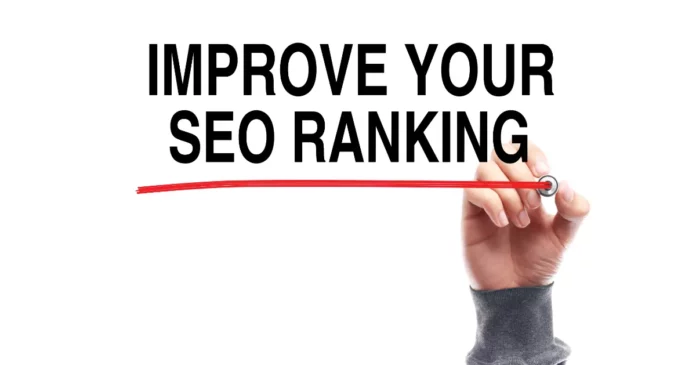In the dynamic landscape of online visibility, mastering the art of search engine optimization (SEO) is paramount for businesses and individuals.
Achieving high rankings on search engine results pages is not just a goal; This is a strategic necessity.
If you want to grow your digital presence and get ahead of the competition, this comprehensive guide reveals 14 proven strategies to elevate your SEO game.
From optimizing content to leveraging technical SEO, we’ll explore actionable insights that can propel your website to the top of search engine rankings.
Get ready to redefine your digital landscape and leave your competitors in the dust!
How To Improve SEO Rankings?
Here are some ways to improve SEO:
1. Update and optimize existing content.
Updating and optimizing your existing content is a strategic step to boost your SEO.
Start by auditing your website to identify underperforming or outdated content.
Look for pages that contain valuable information but may lack optimization.
Revise content to ensure it is up-to-date, relevant, and in line with current trends or industry changes.
Include new information, statistics, or developments that add value to the content.
Update meta titles, meta descriptions, and titles to include targeted keywords that better match the user’s search intent.
Optimizations also include improving readability and user experience.
Break up long paragraphs, use bullet points or numbered lists where appropriate, and include multimedia elements like images or videos to increase engagement.
By improving and optimizing existing content, you can potentially increase its visibility and ranking in search results.
2. Improve your website loading speed.
Website loading speed has a significant impact on user experience and SEO rankings.
Users expect quick access to information, and search engines prefer sites that provide a fast and seamless browsing experience.
There are several strategies involved in optimizing your website’s loading speed.
Utilize efficient image compression techniques to minimize file size while maintaining quality.
Reduce HTTP requests by combining or eliminating unnecessary scripts.
Use browser caching to store frequently accessed resources and improve load times for returning visitors.
Consider leveraging a content delivery network (CDN) to deliver website content across multiple servers globally.
This reduces server response time and improves loading speed, especially for users accessing your site from different locations.
Regularly monitor your website’s loading speed using a tool like Google’s PageSpeed Insights or GTmetrix.
These tools provide insights and suggestions for optimizing speed, helping you fine-tune your site’s performance for better SEO rankings.
3. Structure your content for featured snippets.
Featured snippets are highlighted search results that provide users with immediate answers to their queries.
These featured snippets appear at the top of Google’s organic search results.
Structuring your content to target featured snippets can significantly improve your visibility and click-through rates.
Identify commonly asked questions related to your topic and create content that directly answers these questions.
Format your content in a way that makes it easy for search engines to extract information for featured snippets.
Using structured data markup like Schema.org can help search engines better understand your content, increasing your chances of appearing in featured snippets.
Use appropriate headings (H1, H2, etc.) and provide concise and informative answers to questions in your content.
Experiment with different content formats, such as lists, tables, or step-by-step guides, as these are often preferred for featured snippets.
By strategically structuring your content, you can increase your chances of appearing in these key search result positions.
4. Create new content based on low-competition keywords.
Identifying and targeting low-competition keywords can be a smart strategy to improve your SEO rankings.
Low-competition keywords are those that have relatively little competition but are still relevant to your content or topic.
Tools like Google Keyword Planner, SEMrush, or Ahrefs can help identify these keywords.
Look for long-tail keywords or specific phrases that users may search for but are not heavily targeted by other websites.
Create high-quality and informative content based on these keywords.
Develop comprehensive articles, guides or blog posts that thoroughly cover the topic while naturally incorporating targeted keywords.
Optimizing new content around low-competition keywords gives you a better chance of ranking higher in search results for those specific queries.
Over time, as your content gains visibility and attracts traffic, it can contribute to improving the SEO performance of your overall website.
5. Use Sitelinks.
Sitelinks are additional links that appear below the main search result and take users to specific pages on your website.
These links provide users with quick access to relevant sections or pages of your site, enhancing navigation and user experience.
While sitelinks are automated and generated by search engines, you can influence their presence by optimizing your website’s structure and internal linking.
Make sure the structure of your website is clear and logical, making it easy for search engines to understand the relationship between different pages.
Use descriptive anchor text in your internal links to help search engines determine the content of linked pages.
Although you can’t directly control which sitelinks appear, optimizing your website’s structure and internal linking can increase the chances that search engines will display relevant and useful sitelinks.
This can increase your website’s visibility and attract more clicks, which can have a positive impact on your SEO efforts.
6. Use internal linking.
Internal linking is a powerful strategy to enhance SEO and improve the user experience on your website.
This involves strategically linking your site’s pages to each other.
This practice helps search engines understand the structure of your website and the relationship between different pages.
Consider relevance and context when implementing internal links.
Link related content together to guide users to additional information beyond what they are currently reading.
This not only keeps users engaged but also spreads link equity across your website, thereby improving the ranking ability of different pages.
An effective internal linking strategy involves using descriptive anchor text for links.
Instead of generic phrases like “click here,” use descriptive and keyword-rich anchor text that accurately describes the content of the linked page.
This helps search engines understand the context of the linked content.
7. Get Backlinks from Authority Sites.
Backlinks from trustworthy and relevant sites are very important for SEO.
They act as a vote of confidence for your website’s credibility and expertise.
Getting quality backlinks requires a strategic approach and a focus on creating valuable and shareable content.
Create high-quality content that provides unique insight, valuable information or entertainment to your audience.
Shareable content naturally attracts backlinks from other websites looking for quality resources to link to.
Engage in outreach efforts by reaching out to influencers, bloggers or websites in your industry.
Guest posting, collaborating on projects, or providing expert insight can provide opportunities for backlinks from reputable sites.
Remember, quality matters more than quantity when it comes to backlinks.
Focus on building a diverse backlink profile from authoritative sources, as this can significantly increase your website’s authority and SEO performance.
8. Optimize Images.
Image optimization is often overlooked but plays an important role in SEO.
Optimized images improve website loading speed, enhance user experience, and contribute to better search engine rankings.
Start by using the correct file format and compression to reduce image file size without compromising quality.
Choose appropriate alternative text that accurately describes the image using relevant keywords.
Alt text not only helps visually impaired users, but also helps search engines understand the content of the image for ranking purposes.
Use descriptive and keyword-rich file names for images.
Avoid generic file names like “image001.jpg” and instead use descriptive names that reflect the content of the image.
This practice helps search engines understand the image and can improve its visibility in image search results.
Consider implementing responsive design techniques to ensure images seamlessly adapt to different devices and screen sizes.
Optimized images not only contribute to better user experience but also have a positive impact on SEO rankings.
9. Optimize for on-page SEO factors.
On-page SEO involves optimizing individual web pages to rank higher and earn more relevant traffic in search engines.
This includes various factors such as title, meta description, title and optimizing the content for search engines and users.
Create compelling and descriptive titles that include targeted keywords and accurately reflect the content of the page.
The meta description should provide a brief summary of the page’s content, which will entice users to click through to your website.
Use heading tags (H1, H2, etc.) to logically structure your content.
Incorporate targeted keywords naturally into titles and content, ensuring readability and relevancy.
Organize content into digestible sections using headings to improve user experience and signal content hierarchy to search engines.
Optimize your content by doing keyword research and naturally integrating relevant keywords throughout the text.
Prioritize providing valuable and informative content that satisfies user intent, as search engines prefer content that answers user questions effectively.
10. Fix broken links.
Broken links, also known as dead links or 404 errors, have a negative impact on user experience and SEO.
They cause frustration for users trying to access content and can harm your website’s credibility in the eyes of search engines.
Regularly check for broken links on your website using tools like Google Search Console or online broken link checkers.
Once identified, immediately fix broken links or redirect them to relevant pages on your website.
Implementing a custom 404 error page that provides useful information and navigation options can minimize the negative effects of broken links.
Make sure users are directed back to the functional pages of your website even when they encounter broken links.
By promptly addressing broken links, you improve the user experience, prevent potential penalties from search engines, and maintain the integrity of your website’s SEO.
11. Target Brand New Keywords.
Keyword targeting is at the heart of SEO.
While it’s important to focus on existing keywords, targeting brand-new keywords can expand your reach and attract a wider audience to your website.
Start by doing thorough keyword research.
Find new keywords that are relevant to your topic but may not be extensively targeted yet.
Tools like Google Keyword Planner, SEMrush, or Ahrefs can help identify these unused keywords.
Focus on long-tail keywords or specific phrases that align with user intent and have reasonable search volume.
These keywords often have less competition, making it easier for your content to rank higher in search results.
Once you have identified new keywords, create optimized high-quality content based on these terms.
Develop comprehensive articles, guides or blog posts that provide valuable information to users searching for these specific keywords.
By targeting new keywords, you can attract fresh traffic and increase your website’s visibility in search results.
12. Create Linkable Assets.
Creating linkable assets is a strategic approach to attracting backlinks and improving the authority of your website.
Linkable assets are pieces of content or resources that are valuable, shareable, and likely to attract links from other websites.
Consider creating in-depth guides, original research, infographics, interactive tools or unique resources in your field.
These assets should provide adequate value and be of interest to your target audience and industry experts.
Promote your linkable properties by reaching out to relevant websites, influencers or bloggers in your industry.
Share your content and offer it as a resource that your audience can benefit from.
Engaging in outreach efforts and collaborations can lead to organic backlinks from authoritative sites.
Regularly update and maintain your linkable assets to ensure they remain relevant and valuable.
By consistently producing high-quality and link-worthy content, you can attract backlinks, increase your website’s authority, and improve SEO performance.
13. Make sure your site is mobile-friendly.
In today’s digital landscape, it’s important for SEO that your website works well on mobile devices.
With a large portion of Internet users accessing content via mobile devices, it is important to ensure a seamless mobile experience.
Implement responsive design techniques that enable your website to adapt and display correctly across different devices and screen sizes.
Test your website’s mobile-friendliness using a tool like Google’s Mobile-Friendly Test to identify and fix any issues that may hinder the user experience on mobile devices.
Optimize loading speeds for mobile users by eliminating unnecessary scripts, reducing image file size, and taking advantage of browser caching.
A fast-loading mobile site enhances the user experience and has a positive impact on SEO rankings.
Mobile-friendly websites are loved by search engines, and having a responsive design not only meets the needs of mobile users but also signals to search engines that your website offers a quality user experience on all devices.
14. Track metrics with Google Analytics.
Tracking and analyzing website metrics is essential to understand your SEO performance and make informed decisions.
Google Analytics is a powerful tool that provides valuable insights into user behavior, traffic sources, and website performance.
Set up Google Analytics to track key metrics like website traffic, user demographics, popular pages, bounce rates, and conversion rates.
These metrics provide valuable information about what is working well on your website and what areas need improvement.
Analyze organic search traffic to identify keywords and the performance of individual pages that drive traffic to your site.
This information helps you refine your keyword strategy and optimize content for better rankings.
Monitor user engagement metrics such as time on page, pages per session, and click-through rates to assess content effectiveness.
Identify high-performing content and replicate the strategies that work to improve poorly performing pages.
Regularly reviewing Google Analytics data allows you to make data-driven decisions, improve your SEO strategies, and continually improve your website’s performance in search engine rankings.
Conclusion.
As you finish this exploration of SEO strategies, remember that the digital sphere is constantly evolving, and so is the landscape of search engine algorithms.
The 14 methods shared here provide a strong foundation for strengthening your rankings, but don’t stop there.
Constant optimization, testing, and optimization are the keys to lasting SEO success.
To ensure your website maintains its competitive edge, keep refining your content, monitor analytics, and stay up to date on industry trends.
By implementing these strategies and embracing the evolving nature of SEO, you are ready to not only improve your rankings, but also get ahead in the dynamic digital arena.







